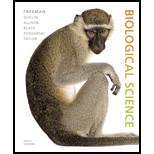
Concept explainers
What are the four nitrogenous bases found in RNA?
a. cytosine, guanine, thymine, uracil (C, G, T, U)
b. adenine, cytosine, guanine, thymine (A, C, G, T)
c. adenine, cytosine, guanine, uracil (A, C, G, U)
d. alanine, cysteine, glycine, threonine (A, C, G, T)
Introduction:
The five nitrogenous bases consist of nitrogen-containing molecule used in the construction of nucleotide, a polymer that is the building block of the nucleic acids like DNA (deoxyribonucleic acid) and RNA (ribonucleic acid).
Answer to Problem 1TYK
Correct answer:
Adenine, cytosine, guanine, and uracil (A, C, G, U)
Explanation of Solution
Explanation/Justification for the correct answer:
Option (c) is given that A, C, G, and U are the nitrogenous bases found in the RNA. A group of five nitrogenous bases is utilized in building the nucleotides. The nitrogenous bases include adenine, guanine, cytosine, thymine, and uracil. The nitrogenous bases can be purines or pyrimidines. The adenine and guanine are six-membered nitrogen-containing rings; and they fall under the purines. While, thymine, uracil, and cytosine are six-membered nitrogen-containing rings; and they fall under pyrimidines. Uracil is found in the RNA and complements adenine instead of thymine. Hence, option (c) is correct.
Explanation for incorrect answers:
Option (a) is given that C, G, T, and U are the nitrogenous bases found in the RNA. In case of DNA, adenine forms double bonds with thymine. Adenine complements either thymine or uracil. There is no strand that consists of both thymine and uracil. So, it is a wrong answer.
Option (b) is given that A, C, G, and T are the nitrogenous bases found in the RNA. A, C, G, and T nitrogenous bases are found in the DNA. In RNA, uracil is present in place of thymine. So, it is a wrong answer.
Option (d) is given that A, C, G, and T are the nitrogenous bases found in the RNA. Alanine, cysteine, glycine, and threonine are not found as nitrogenous bases in DNA or RNA. These are amino acids that form codons and each amino acid has multiple codons. So, it is a wrong answer.
The four nitrogenous bases found in RNA are adenine, cytosine, guanine, and uracil (A, C, G, U).
Want to see more full solutions like this?
Chapter 4 Solutions
Biological Science (6th Edition)
- A) What is the difference between a nucleoside and a nucleotide? B) Give any two differences between DNA and RNA. C) Draw the structure of deoxyribose and ribose below, and number the carbons. What is the difference between the two structures? Please answer all 3 partsarrow_forwardWhich of the following is false regarding a DNA molecule? a-It contains a double helix structure b-It stores genetic information c-It contains the nitrogen base Uracil d-It contains base pairsarrow_forwardWhat are the three components of a nucleotide? With regard to the 5′ and 3′ positions on a sugar molecule, how are nucleotides linked together to form a strand of DNA?arrow_forward
- what are 3 types of RNA?arrow_forwardA friend tells you that only four differentkinds of bases are found in RNA. What would you say in reply?arrow_forwardDNA and RNA are both nucleic acids, but their structures and functions differ. Which of the following options correctly describes the structures and functions of DNA and RNA? a RNA is made from DNA and is used in transcription, while DNA is used in translation. b DNA is a double helix that is used to make proteins, while RNA is single-stranded and used to make lipids. c In DNA, adenine, thymine, guanine, and cytosine join together and carry all of the genetic information. RNA is made from adenine, uracil, cytosine, and guanine and is used to make proteins. d DNA is a double helix that carries all of the genetic information of an organism, while RNA is single-stranded and carries only half of the genetic information.arrow_forward
- Which is a difference between an alpha-helix and a beta-pleated sheet? Select one: a. An alpha-helix contains mainly amino acids with polar R-groups while a beta- pleated sheet contains mainly amino acids with non-polar R-groups. b. An alpha-helix contains disulfide bonds while a beta-pleated sheet contains ionic bonds. c. An alpha-helix has non-covalent bonds between amino acids near each other in the sequence while a beta-pleated sheet has non-covalent bonds between amino acids far apart in the sequence. d. An alpha-helix has a spiral shape while a beta-pleated sheet has a compact zig-zag shape.arrow_forwardWhat are the main types of nucleic acids? Differentiate nucleic acids, nucleotides, and nucleosides What are the main components of a nucleotide? please answer allarrow_forwardHow are the structures of DNA and RNA similar? How are they different?arrow_forward
- Which is a difference between B-DNA and A-DNA? A. For polynucleotide strands containing the same number of nucleotides, the B-DNA strand will be shorter from end-to-end than the corresponding A-DNA. B. Both are helical, but B-DNA is right-handed and A-DNA is left-handed. C. The sugar in A-DNA is more oxidized than that in B-DNA D. Helical structures in RNA predominantly adopt the B-DNA conformation. E. None of the above. The tetranucleotide AGTC (in DNA) has a free hydroxyl group on ____. A. A B. G, T, and C C. C D. A, G, T, and Carrow_forwardName the bases in the pentanucleotide with the sequence G-A-U-C-A. Does this come from RNA or DNA? Explain.arrow_forwardIn the DNA structure, a purine molecule always binds with a pyrimidine molecule. How would you expect the structure to differ if Adenine forms base pairing with Guanine and Cytosine forms base pairing with Thymidine? Instead of A-T, G-C; can it be A-G, C-T? Justify your answer within five sentencesarrow_forward
 Human Heredity: Principles and Issues (MindTap Co...BiologyISBN:9781305251052Author:Michael CummingsPublisher:Cengage Learning
Human Heredity: Principles and Issues (MindTap Co...BiologyISBN:9781305251052Author:Michael CummingsPublisher:Cengage Learning
